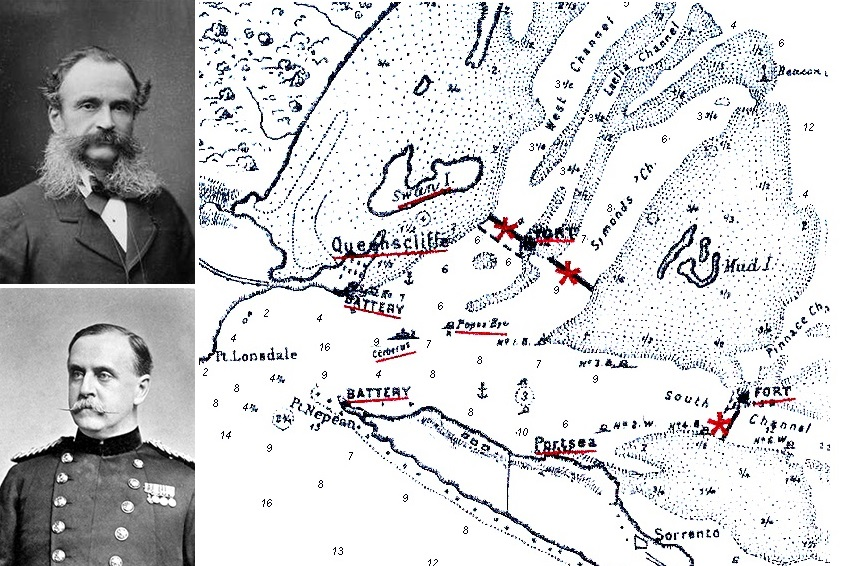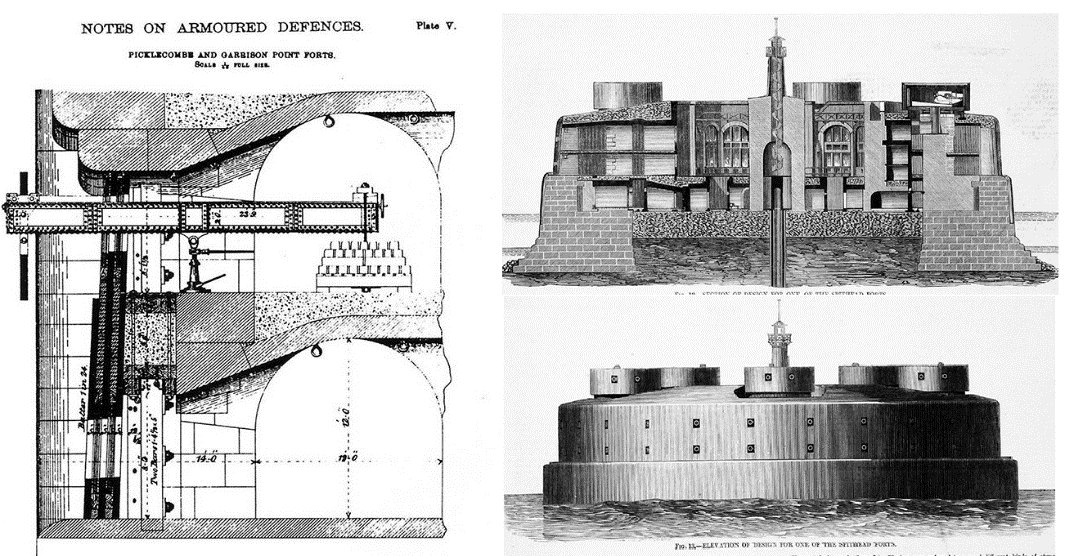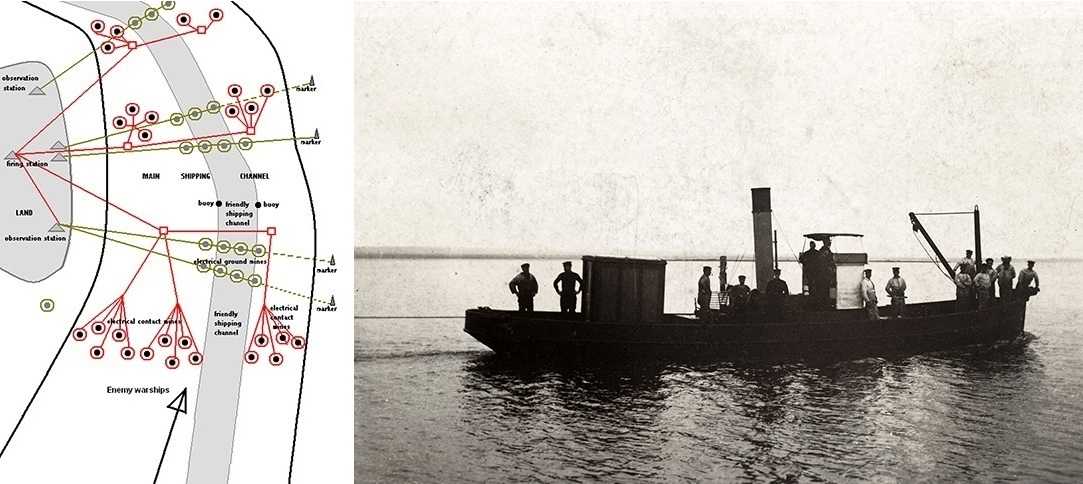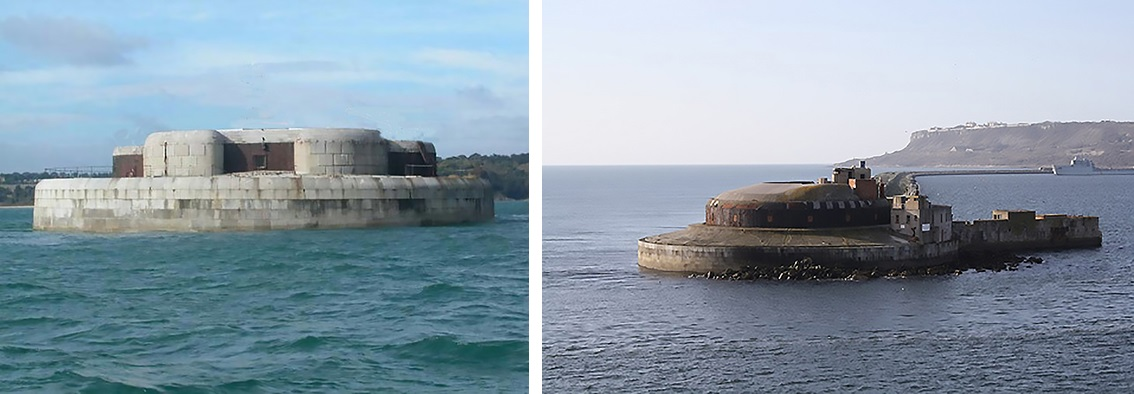In 1860 the Victorian Colony sought advice on suitable defences to protect Port Phillip from naval attack. An expert fortress engineer, Captain Peter Scratchley R.E., was assigned by the UK Government in 1860 to devise a plan. Scratchley was against any attempt to defend the entrance to Port Phillip and instead supervised construction of eight shore batteries at Williamstown and Sandridge to defend Hobson’s Bay. Before departing Victoria in 1863, he recommended a halt to the arming of the batteries with recently acquired 68-pounder Muzzle loading (ML) guns, until testing of new heavy ordnance at Shoeburyness was complete.
Analysis of the destruction of coastal forts during American Civil War, the construction of warships with iron armour, and major advances in British gun technology, dramatically emphasised the inadequacy of shore batteries at Sandridge firing above a parapet – ‘en barbette’. At the Williamstown battery guns firing through open embrasures in earthen parapet walls were almost as exposed to enemy fire. The Victorian government seriously considered locating two iron casemate sea forts in Hobson’s Bay. However, a projected cost of £200,000 per fort proved daunting and further War Office advice was sought. As an interim measure Victoria acquired a wooden ‘Ship-of-the-Line’ from the Royal Navy Reserve (H.M.S. Nelson an ageing 48-gun converted to auxiliary steam power) to serve as a training vessel and block-ship (1868), and the remarkably advanced armoured breastwork monitor – H.M.V.S. Cerberus – designed by Edward James Reed specifically for harbour defence (1870).
Upon his return to the UK in 1864, Scratchley was appointed to the manufacturing departments of the War Office as ‘Assistant Inspector of Works’, and a decade later he became ‘Inspector of Works’, with the rank of Brevet Lieutenant-Colonel. As a Royal Engineer and military architect, Scratchley’s charge was the extensive engineering works connected to the great arsenal and store depot at Woolwich – where the guns, carriages, ammunition, and warlike stores for the army and navy were manufactured. His work also encompassed the ‘Coast Artillery School’ at Shoeburyness – where continuous experiments on ordnance and armour plates for warships and fortification structures were conducted during his term at the War Office. Scratchley continued to provide technical advice to Victoria’s Agent-General in London. Following a joint Victorian – NSW request for Imperial guidance on harbour fortifications in 1876 , he was selected to proceed to Australia as Adjutant to Major-General Sir William F. Jervois – where they would jointly advise colonial governments on defence needs. Jervois and Scratchley reached Melbourne circa March, 1877 , and promptly produced a preliminary defence report that included a proposal for two three-tier sea forts in the vicinity of the South and West channels – although the ordnance remained unspecified.

1878 VPP – Archive at Fort Queenscliff Museum
In early 1878 Jervois was appointed Governor of South Australia and Scratchley became ‘Commissioner of Defences’ to the Colonies of Victoria, New South Wales, Queensland, Tasmania, and South Australia. Scratchley’s ‘1879 Revised Report on the Defence of Port Phillip’ was largely premised upon information gathered by Jervois while he was on leave in the UK during 1878. It provided for coastal forts to be established at Queenscliff, Point Nepean and Swan Island, with a suggestion that a pair of two-tier sea forts should be constructed on shoals in Southern Port Phillip. ‘…. As regards the work for the defence of the passage through the shoals, it is proposed that each shall be constructed for five powerful muzzle-loading rifled guns to seaward and three 80-pounders bearing on the shoal waters in flank and rear. The borings indicate that at the site between the West channel and Symonds channel there is a depth of almost ten feet, and at the site near No. 5 buoy, about twenty feet of sand resting upon sandstone. In either case a good foundation may be formed by enclosing the requisite space by piding of practically impermeable material – shod with iron and placing a thick layer of concrete, up to a level of about eighteen inches above low water on the space thus enclosed. A ring of rubble stone should be thrown in round the foundation, to protect it against injury that might otherwise occur from the action of the sea at the level where the piling enters the sand. On the foundation thus formed, a basement of masonry and concrete may be built, which will contain the requisite torpedo and store rooms, the tanks, and magazines for the work, and upon this basement will be placed the battery and the accommodation for the artillerymen to man the guns. The five seaward guns will be in casemates; protected by an iron front, and the three other pieces will be in open battery, each gun having a wide sweep. Considering the length of the ranges, both at the entrance and upon, the anchorage, it is proposed that the heavy Rifled Muzzle Loading pieces (RML) at the two forts on the shoals, as well as at Point Nepean shall be 11-inch, 25 ton guns.’
Progress in carrying out Jervois’ scheme of defence at Port Phillip Heads was protracted. Scratchley reported that the scarcity of progress was entirely due to the absence of necessary authorization from the Government to proceed with works during the years 1877-78 and 1878-79, and to insufficiency in the amounts voted during 1879-80, 1880-81, and 1881-82. On the Great Sand, near the No.5 buoy in South Channel, a contract (£8,996) for construction of a rubble stone annulus was commenced by the contractors, Messrs. Noonan Brothers, on the 4th August, 1879, and completed on 12th May, 1880, when all construction work on the fort ceased.

Author’s Collection
Jervois preferred location for an annulus fort in West Channel was under dispute, as a second location – Pope’s Eye shoal – was favoured by Scratchley. In spite of a surfeit of Defence Inquiries and Committee Reports, decisions on position or structure were rarely formalized. (By 1890 there had been 10 individuals, 2 Defence Commissions & 2 Select Committees of Inquiry, who had provided reports) Jervois informed Scratchley that, ‘During my recent visit to England I learnt that a great stride is being made in the power of artillery. It has been ascertained that by enlarging the bore of a gun at the part occupied by a charge of powder, and by lengthening the gun itself, much larger charges can be used and consumed. Consequently greatly increased velocity can be obtained.’ Armstrong & Co. of the Elswick Ordnance Company (EOC) now contemplate making a 10-inch gun which will exceed in power the ‘service’ 12-inch gun.’ He had also stressed torpedo minefields were essential to any Heads defence plans. However, the colony’s torpedo mines were stored on the hulk Deborah off Williamstown and needed to be moved by barge to a location more than 30 miles when needed at the Heads. The organization of the Heads minefields had been placed in the hands of a small volunteer Naval Torpedo Corps of 40-60 boatmen resident at Williamstown, utilizing a small steamer for mine laying.

Archive photo; Fort Queenscliff Museum
Jervois also reported that ‘… the length of the new 10-inch will considerably exceed that of the ‘Service’ 11-inch gun. On this account the recoil will not be sufficient to admit of ready access to the muzzle when the piece is in the casemate; and I therefore recommend that, for facility of loading, those guns which will be mounted in casemates should be breech loaders. Armstrong & Co., have an excellent plan for breech loading, which I saw at Shoeburyness, in a gun recently constructed by them.’
Problems with the design of South Channel Fort and Pope’s Eye Fort were outlined by Sir Thomas Bent (Commissioner of Public Works) in 1880. He suggested in the ‘House’ that Imperial advice based upon tests conducted at the Royal Artillery Shoeburyness test range against an iron facsimile target of the ‘Plymouth Breakwater Fort’ indicated defences constructed at sea level would need to be heavily vaulted stone and concrete casemates, with the gun deck protected behind heavy armour plates. As Imperial demands for armour plate on ironclad warships and Britain’s coastal forts could barely be matched by British foundry production, it was unlikely that Colonial requirements would be met – at least in the short term. A further problem in 1880 was a recommendation from C.B. Payne, Victoria’s Chief Harbour Master, that Symond’s Channel be dredged and made the sole entry channel to Hobson’s Bay. While his suggestion was not taken up, it temporarily placed serious doubt upon the need for fortifications in South Channel.

Two possible choices open to Scratchley in his attempt to reduce the proposed South channel sea fort to a two-tier fort – with a single gun deck and rooftop ‘Cole’s’ turret. St Helen’s Fort utilized casemates with laminated iron gun shields, a less expensive option than at the Portland Breakwater Fort, where the casemate was clad with a full outer skin of iron-armour.
Photos: Author’s Collection
In Paragraph 4 of his ‘March 1882 Defence Report’ Scratchley quoted Jervois, as stating ‘… I propose that 10-inch guns of the new description should be supplied for those parts of the Port Phillip defences which I formerly proposed should be armed with 11-inch guns. The precise pattern of 10-inch gun to be adopted should be determined after communication with artillery authorities in England.’ (The longer barrel ‘Woolwich’ 10-inch, 20-ton RBL gun undergoing testing – fired a 410-pound projectile to a maximum range of 5,944 metres, (6,500-yards) with muzzle velocity at 498 metres per second.
Confusingly, in Paragraph 5 of the same report Jervois is quoted as reporting, ‘… in any case the length of the new 10-inch will considerably exceed that of the ‘service’ 11-inch gun. On this account the recoil will not be sufficient to admit of ready access to the muzzle when the piece is in the casemate; and I therefore recommend that, for facility of loading, those guns which will be mounted in casemates should be breech loaders. Armstrong & Co., have an excellent plan for breech loading, which I saw at Shoeburyness, in a gun recently constructed by them.’ However, ‘Schedule A.’ of the ‘Scratchley Report, 1882’ relating to South Channel Fort proposed –
• Fort on shoals to guard channel & submarine mines
• To be armed with five 10-inch & two 6-inch rifled guns
• Tower for two 10-inch guns in cupolas
• Casemate for two 6-inch guns – with three machine guns on the roof
• Estimated cost £80,000
In Para. 10 – Jervois advice was, ‘… As regards the superstructure, the massiveness of the work and the thickness of the iron front of the casemate should be such as to meet… the increased power of artillery, bearing in mind that the powerful guns which it is proposed to adopt in the defence will be capable of preventing any armoured vessel likely to appear in Australian waters from engaging the fort, except at a very distant range.’
The Argus newspaper reported on March 22, 1882, that ‘… with regard to the fort to be constructed in the South Channel, a modification has been made, with the sanction of Sir Wm. Jervois R.E. Originally proposed by Sir Wm. Jervois, this fort was to have been an exceptionally strong and very heavily armed three storied building, and its cost was estimated at from £200,000 to £300,000. The one to be carried out is a two storied fort of a substantial character, estimated to cost about £80,000. It will have two 25-ton guns, with cupolas and several small side guns for the protection of the torpedo defences. This fort, however, will take at least two years to build, and what the Government propose to do at present is to expend £150,000 on gun and torpedo boats, and the improving and arming of the batteries at Swan Island, Queenscliff, and Point Nepean.’
Further delays in progress were attributable to Defence Minister Sir Frederick Sargood deciding in 1883, after communications with Victoria’s Agent-General in London, to again await the result of the gun experiments at Shoeburyness. The Agent-General stated the War Office still had the best form of mounting armament at South Channel under consideration, as well as the best form of cupola (turret) for ten-inch RML guns. Problems with turning a ‘Coles’ turret without the application of steam power would prove insurmountable – as was the predicted cost of £8,000 – £15,000 for a turret containing twin 10-inch gun (exclusive of the gun cost).
Comparative cost of Sea Fort: No Man’s Land Fort – £462,500
Spitbank Fort – £167,300
St Helen’s Fort – £123, 311
Portland Breakwater Fort – £ 75,968
Iron-Casemate South Channel Fort – £200,000 – £300,000
Revised South Channel Fort – £80,000
Click Here for Part 2
Contact Keith Quinton about this article.






